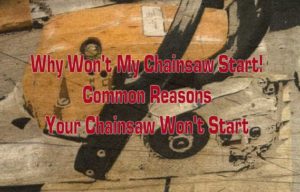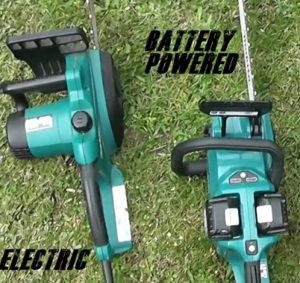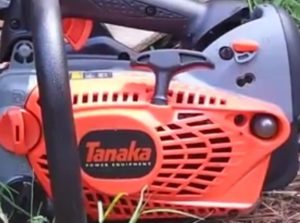I hope you love the products I've recommended below, just a heads up that as an Amazon associate, I earn from qualifying purchases. This means I may earn commissions on products bought via links on this page.
 Chainsaws are complicated machines and trying to find out why my chainsaw won’t start can be a long-drawn-out process. The question of why won’t my chainsaw start can be very hard to answer since the smallest thing can make a perfectly fine chainsaw go from working to being a large paperweight.
Chainsaws are complicated machines and trying to find out why my chainsaw won’t start can be a long-drawn-out process. The question of why won’t my chainsaw start can be very hard to answer since the smallest thing can make a perfectly fine chainsaw go from working to being a large paperweight.
Since there are so many reasons as to why a chainsaw might not start it can be hard to pinpoint what is exactly wrong which makes this difficult. There are a number of things you can do to help narrow what could potentially be wrong with your chainsaw.
Even once you work out what the cause of the problem is sometimes fixing can be just as big of an issue as finding the problem was. With this in mind, it’s time to find out what could be causing your chainsaw to not start and if there is anything you can do about it!
Chainsaw Will Not Start Problems
There could be a number of problems for your chainsaw and why it won’t start and all you can do is go with the process of elimination. In my opinion, this is the way to start trying to fix anything that might be broken and the first thing you should do for your chainsaw.
One thing to note is that having knowledge and experience with dealing with a chainsaw is highly advisable as it can get quite complicated. If you don’t have this capability then it’s advised to either go to your dealership or a local mechanic and pay someone to fix it for you if you have the funds to do so.
Can The Weather Cause A Chainsaw To Not Start?
The weather can play a large factor in whether your chainsaw will start or not and a lot of people don’t even consider it. Paying attention to it can help you from having some issues with starting your saw.
In most cases, cold weather can play a big factor in why your chainsaw won’t start. The best way to counter this is to let the chainsaw warm up first before you start cutting.
Learn How To Start Your Chainsaw Properly
While this may not seem like the most obvious thing but the number of times I’ve seen someone with a new chainsaw trying to start it like it was there old one and complain it won’t start is incredible.
All chainsaws are different and starting them will differ between the different manufacturers and can even differ between models from the same manufacturer. So you should always read the manual that comes with your chainsaw and follow it step by step.
You’d be surprised at the number of times this has fixed the problem for people so it’s always worth checking in my experience.
Troubleshooting Why A Chainsaw Isn’t Starting
How Long Has Your Chainsaw Been Sitting?
This may not be exactly the first thing you might not think of but can cause a lot of problems. If a chainsaw sits for a long time and wasn’t stored properly it can cause you all kinds of headaches and be a reason your chainsaw won’t start.
If the fuel in the chainsaw is old then it’s a good idea to drain your fuel in the chainsaw and replace it with some new fuel. This can help solve some issues and if it was the case I’d advise learning how to store your chainsaw properly.
Have You Flooded It?
On the topic of fuel in the chainsaw, there is a chance that you may have flooded the engine which caused you chainsaw to not start. Flooding your chainsaw is easy to do if you’re not very experienced and happens when you put to much fuel in your chainsaw.
A good idea is to drain a bit of the fuel out of the chainsaw then let it run idle for 10 to 20 minutes. This will help it evaporate some of the excess fuel and might be the reason your chainsaw won’t start.
Is The Carburetor The Issue?
The carburetor of a chainsaw is important and can be the reason that the chainsaw won’t start and the fix can either be simple or expensive. The carburetor can get clogged from leaving fuel in the chainsaw which can make some of the fuel evaporate. What this does is leave the thicker and stickier ingredients behind.
This clogs up the carburetor and you will need to clean it with a carburetor cleaner which might solve the problem. If it doesn’t solve it then your left with the more expensive option of replacing the carburetor which can get expensive if you have to pay someone to do it.
Check Spark Plugs For Spark
The spark plugs on a chainsaw are extremely crucial and can be the main reason your chainsaw is not starting. You can either check for spark or just replace the spark plug with both options being viable with the chance you’ll have to do both either way.
The spark plug might not be sparking and be the cause of your chainsaw not starting and finding out if that’s the case can be a little difficult. Below I’ve included a video of how to check for spark since it can be a little overwhelming when reading how to do it.
The Ignition Coil Could Be Defective
Once you’ve checked the spark plugs for a spark or have replaced the spark plugs and they’re working then your next option is to check the ignition coil. The ignition coil is an important part as it sends the voltage to the spark plug when the engine is running so you can see why if it’s broken it can cause an issue.
You will need an ignition coil tester to find out if it’s defective or not. If it’s defective and not working then you will need to replace it or have someone replace it for you.
Recoil Starter
If your starter is broken then your chainsaw will not turnover and will not start so it’s important to work out if this is what’s broken. Removing the starter and inspecting it is the first step into seeing if it’s why your chainsaw won’t start.
To do this you will need to remove the recoil starter assembly. You’ll need to pull the rope and see if the tabs that extend from the cam will grab the hub of the engine which is what will make the engine start. When you release it and if the tabs don’t retract then I have some bad news for you, you’ll need to replace your recoil starter.
Recoil Starter Pulley, Or Rewind Spring
I put these two together since they’re all somewhat connected and related to each other. With the recoil starter pulley is in charge of retracting the starter rope it’s just one of the many important things for a chainsaw.
It could either be broken or get stuck with one being a bit more costly than the other. If it gets stuck trying to get it unstuck is a viable option but difficult. If it’s broken you’re stuck with the same answer as a lot of these problems and replace it.
The rewind spring is connected to the pulley in that when the starter rope is pulled the rewind spring is in charge of recoiling it to the pulley. If this is broken you’ve only got the option of replacing it which then it’s usually best to replace the entire recoil starter assembly.
How To Minimize Chainsaw Starting Problems
While there is no guaranteed way of making sure your chainsaw always starts since sometimes it’s just bad luck and something goes wrong. There are still some things you can do to help prevent it and increase the life of your chainsaw which is always a good thing since they’re expensive.
Whether you’re a beginner or a professional these are things everyone should do to keep their chainsaw up and running. I believe everything here should be followed with them all being important and none being less important than the other.
Maintenance Is King
This really should go without saying but you need to maintain your chainsaw to keep it up and running smoothly. Failure to do so will end up costing you a lot more dramas and potentially more money in the future. So learning how to maintain your saw is crucial to increase the life span of your chainsaw.
Even just doing the basic maintenance will help keep your chainsaw healthy. So you don’t need to be that person who is obsessed with their chainsaws and never leave there shed because they’re always maintaining them. Not that’s there anything wrong with doing that since maintenance can be enjoyable when you know what you’re doing.
If you have never done maintenance on a chainsaw before then you could always pay someone to do it for you. This is useful if you have the funds and don’t particularly want to learn how to do the maintenance. Tho I recommend at least learning a bit about chainsaws to make sure you’re prepared in the worst-case scenario.
Learn How To Use The Chainsaw Properly
Another really basic thing but often overlooked is learning how to properly use a chainsaw. You shouldn’t just sit on the throttle at all times and let it heat up and cook itself. So having a basic understanding of how to use your chainsaw is important and something you should learn how to do.
I always recommend reading the manufacturer’s guide when it comes to operating a chainsaw. While it may come across as them babying the chainsaw in the guide but they would know the chainsaw better than anyone using it. So you should always follow the instructions on how to use your chainsaw.
Once you’ve learned how to start your chainsaw properly the next step is to learn how to cut properly. Making sure you don’t just drive the tip of the chainsaw into a tree head first and completely ruining the chain and possibly the bar. Making sure you know how to oil your chain and bar correctly will make a world of difference in keeping it alive longer.
Store Your Chainsaw Properly
In my opinion, this is one of the most overlooked things when it comes to keeping your chainsaw healthy. Most people might give their chainsaw a little clean after use then just let it sit in the shed for months then wonder why it won’t start when they come back to it.
Learning how to store your chainsaw properly will save you a lot of headaches and money if you learn how to do it properly. Not storing it properly can lead to your carburetor clogging up and your chainsaw not starting so it’s a good idea to store it properly.
Does Gas Or Cordless Chainsaws Have More Starting Problems
Most people in the chainsaw industry would laugh it this question since most of them of a disposition of gas is the only way to go. Which I can understand why since they’ve been the industry standard for so long and it’s what they’re all used to so they won’t try anything else.
Since gas has been the standard for so long cordless chainsaws often get overlooked since they’re not as heavy-duty as a gas saw. But they offer other advantages that a gas chainsaw can’t so they shouldn’t be ignored in my opinion.
Reasons A Gas Chainsaw Won’t Start
Gas chainsaws are excellent pieces of equipment that are the kings of the yard for good reason. What if I told you that there is an area where they’re not the king of and it’s an important one for a chainsaw.
There is one big drawback to a gas chainsaw and it can be quite a problem for some. This is how hard they are to start when they’re cold and how it can feel like you’ve had to rip your shoulder out of your socket to start it. This is a pretty big downside for some people and makes using a gas chainsaw a problem.
In my experience, gas chainsaws have a lot more issues than any other type of chainsaw. This makes sense with all the moving parts that are involved in a gas chainsaw there is a lot more that can go wrong. I don’t think this is a deal-breaker in a lot of cases but there is a record of them breaking more than other chainsaws.
Cordless Chainsaw Issues
While cordless chainsaws can be a little underpowered so they can’t handle the bigger jobs a gas saw can. There are two things that they have over a gas chainsaw and that’s how easy they’re to start and how they rarely break down compared to gas chainsaws.
Most cordless chainsaws are very plug and play with how they work. Just plug the battery in and pull the trigger and you’re ready to go. So starting them is much easier than a gas chainsaw in mine and many others’ opinions.
Cordless chainsaws also have fewer problems overall compared to gas chainsaws. This is because of the obvious lack of a gas engine which is usually the majority of problems you’ll face for a chainsaw. So a cordless chainsaw is a great option if you’re not planning on cutting anything too large.
Why Won’t An Electric Chainsaw Start
Cordless chainsaws are great at doing certain jobs that are close to the house and that don’t need a lot of power. But this doesn’t mean they don’t have there own level of problems that can make them not start.
One of the most common issues I see with these types of chainsaws not working is they’re not getting enough power. A big cause of this is using the wrong gauge of extension lead so your chainsaw isn’t getting enough power which is a big issue for some corded electric chainsaws.
The hardest thing with a corded electric chainsaw is that it’s almost impossible to fix them yourself unless you have some kind of electrical degree. Otherwise, I wouldn’t recommend trying to fix a corded electric saw as it can be extremely dangerous. In most cases, it’s worth just replacing the chainsaw if it’s possible.
Did Chainsaws Use To Last Longer In The Past?
I see this being said or asked a lot in the chainsaw community with someone who has a 30-year-old chainsaw that outlasts their newer saw that lasted a year. So it’s easy to understand why people think that chainsaws don’t last as long as they use to.
There could be a number of reasons why it seems like this is the case with most people blaming the EPA that forced chainsaws to make some changes to their emissions. While there isn’t any proof that this is the case that hasn’t stopped people from claiming such things.
One thing that people don’t take into account is the sheer number of chainsaws that are on the market with a lot of cheap Chinese chainsaws. Not all of these chainsaws are bad but there is a big lack of quality control in some of these chainsaws they just aren’t going to stand the test of time.
Something that will help in keeping your chainsaw alive is looking after it properly and doing a good amount of maintenance. A lot of those chainsaws that you see that are 30 years old have been looked after extremely well which will help in keeping them alive.
What Brands To Look For To Keep The Quality High
Thankfully there are some brands that still keep the quality high and have a far higher chance of lasting you a long time. So the next time you go looking for a new purchase on a chainsaw these are some of the brands that you should keep an eye out for in my opinion.
The most obvious brands you should look for will always be Husqvarna and Stihl. There is a reason that these two companies have been the market leaders for so long and for good reason. Husqvarna has a large range of chainsaws that are high quality and Stihl offers a lot of professional-grade chainsaws that you can’t go wrong with.
While you can’t go wrong with Husqvarna and Stihl there are still a few other bands that offer high-quality chainsaws. These are Echo and Tanaka chainsaw which are some of the finest there are on the market. Tho neither brand gets the same level of admiration that Husqvarnas and Stihls do in my opinion.
While there are a few other brands out there like Jonsered that also produce high-quality chainsaws I’d be here all day listing them off. So just because your favorite brand isn’t on this list doesn’t mean it’s bad and doesn’t serve a spot here.
Get Your Chainsaw Started Now!
Chainsaws are excellent tools that are meant to make your life easier so it’s always a horrible moment when they do breakdown and you’re forced to retire your saw. Thankfully there are a lot of ways of fixing them and if you want to put the time and effort into it then you may not have to give your saw up!
Hopefully, this guide has given you an idea of what might be the cause of your chainsaw not starting. There are so many different causes and trying to nail down what the cause is can be a long and arduous road that even after spending a lot of hours you may not get an answer.
Since it can be such a hard task working what’s the cause of your chainsaw not starting even if you’re a professional there might be something that you’ve overlooked. So it’s always a good idea to try and get some others involved who might just think of something that you might not.
This is why this guide has a lot of different causes that can make your chainsaw almost useless. Once you’ve narrowed down the issue fixing it is usually much easier than figuring out the problem so I hope that this guide has helped you in some way.







